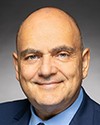In terms of the overall cost of ArriveCAN, at the start of this process, we did not know what the costs would be. In fact, in year one, we expended about $5.6 million, and none of that was funded externally. We had to fund that within the CBSA.
In the second year, we received some additional funding. We received $12.37 million from the Public Health Agency of Canada, and we were in supplementary estimates (B). We also received $12.4 million from Immigration, Refugees and Citizenship Canada in supplementary estimates (C). Therefore, in the second year, we had a $25-million budget, which we managed to a separate cost centre, and that's when we created the new code.
In the third year, we requested funding. In budget 2022, it was announced that the agency would receive $25 million.
Over the course of three years, the money was incrementally provided to the CBSA.
I recognize that it should have been established as a project from the start. It wasn't, and that is very unfortunate, because it meant that we did not have the normal governance structures associated with project management.






